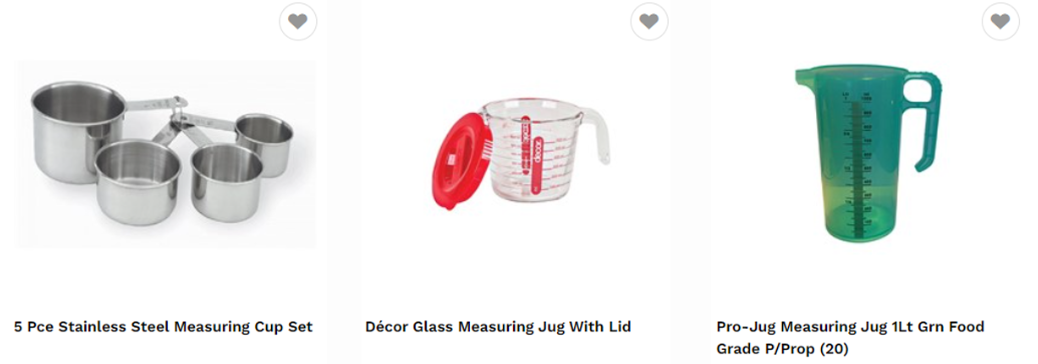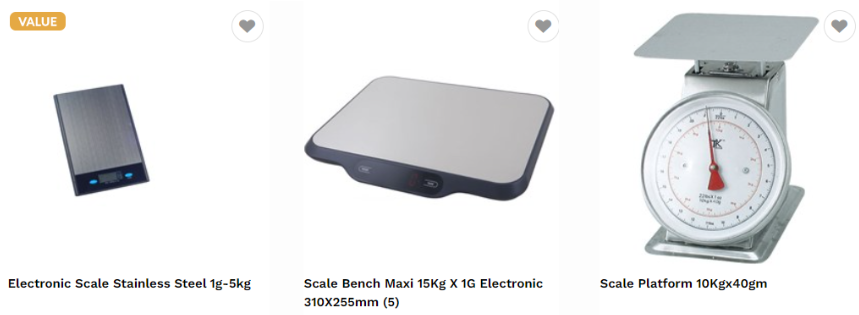When you’re working in a commercial kitchen, you’re used to life being hectic. You need to remain calm under pressure and consistently produce the highest quality food. That means getting your measurements right every time, no matter how busy you are. Luckily, we’re here to help! In this article, we explain a wide variety of different wet and dry measurements, so you’ll never get confused in the spur of the moment again. We also include some handy conversion tables, which you can reference whenever you need to, making your commercial cooking life much easier.
Some of the most common cooking measurements explained
The teaspoon is the smallest of your measuring spoons. In Australian measurements, a teaspoon is the equivalent of 5ml.
One tablespoon is equal to four teaspoons. This means one tablespoon represents a measurement of 20ml.
In metric measurements, a cup is equal to 250ml. However, things become a little less straightforward when we go into fractions of cups. A quarter cup equals 60ml, while one-third of a cup is the equivalent of 80ml. Half a cup is 125ml.

Cooking measurements conversion table
|
|
Teaspoon
|
Tablespoon
|
Cup
|
ml
|
|
|
1
|
|
|
5
|
|
|
4
|
1
|
|
20
|
|
|
|
3
|
1/4
|
60
|
|
|
|
4
|
1/3
|
80
|
|
|
|
6.25
|
1/2
|
125
|
|
|
|
12.5
|
1
|
250
|
Of course, all these measurements refer to liquids. When you need to work out liquid measurements while cooking in a commercial environment, it’s worth having a measuring jug on hand. This way, you can instantly check that you’re pouring the right amount of liquid into your dish.
Measuring the mass of solid cooking ingredients
Solid ingredients are measured in mass. This refers to how much the ingredients weigh. In the Metric system, which we use in Australia, mass is measured in grams and kilograms. One kilogram is equal to 1,000 grams. Obviously, when you’re cooking commercially, it is essential to use exactly the right amount of each ingredient, so you’ll need a reliable set of kitchen scales to avoid any mistakes.
Similar to liquids, solid cooking ingredients can also be measured using teaspoons, tablespoons and cups, but the rules are not always the same as they are for liquids. One Australian teaspoon is equal to 5 grams, while a tablespoon equals 20 grams. One cup holds 250 grams.

Mass conversion table for solid cooking ingredients
|
|
Teaspoon
|
Tablespoon
|
Cups
|
Grams
|
|
|
1
|
|
|
5
|
|
|
|
1
|
|
20
|
|
|
|
|
1
|
250
|
What is the difference between Metric and Imperial cooking measurements?
As we have discussed, Australia uses the Metric system for measuring cooking ingredients. However, not all countries use this system. The USA, for example, uses Imperial measurements, so if you are working from an American recipe, you need to be able to convert from Imperial to Metric if you want to get your measurements right.
In Metric measurements, liquids are measured in millilitres (ml). The Imperial system measures liquids in fluid ounces (fl oz). One fluid ounce is equal to 30ml, while one litre is the equivalent of 35 fl oz. One cup (250 ml) equals 8 ¾ fl oz.
When it comes to the mass of solid ingredients, here in Australia we use grams and kilograms, but the Imperial system uses pounds (lb) and ounces (oz). One ounce is equal to 30g, while 1kg equals 32oz. There are 16 ounces in a pound, so 1kg is the equivalent of 2lb.
Metric to Imperial conversion table
|
|
Metric
|
Imperial
|
Cups
|
|
|
30ml
|
1 fl oz
|
|
|
|
250ml
|
8 3/4 fl oz
|
1
|
|
|
1 kg
|
35 fl oz
|
4
|
|
|
30g
|
1 oz
|
|
|
|
1kg
|
32oz (2 lb)
|
4
|
Find out more about cooking measurements and commercial cooking
If you are cooking in a restaurant or other commercial environment, it is imperative to have a good working knowledge of weights and measurements, as well as to keep up-to-date with all the latest industry developments. Reward Hospitality is always here to help. You can check out some of our handy Catering Solutions here or contact us for more information and advice.